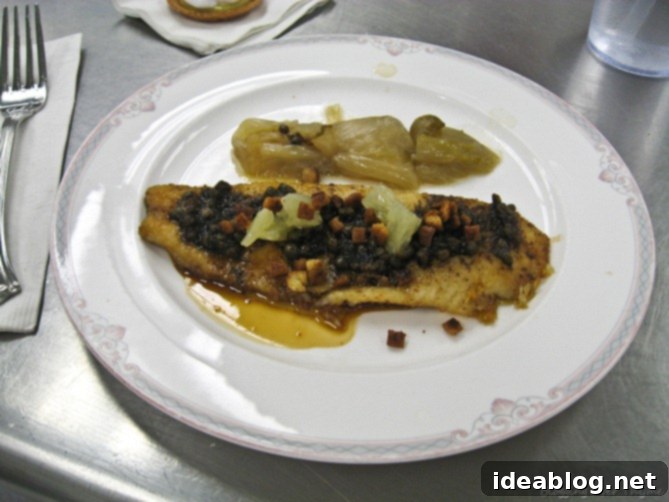Culinary School Week 6: Mastering French Classics from Trout Grenobloise to Key Lime Tartlets
As the sixth week of culinary school commenced, a sense of both excitement and disbelief filled the kitchen. How could time be flying by so quickly? This particular day promised a delightful array of dishes, and I was especially pleased to see fresh fish back on the menu. Today’s star was rainbow trout, a personal favorite known for its delicate flavor and tender texture. It was an excellent choice for exploring classic French preparation methods and refining our filleting and searing skills, setting a high standard for the week ahead.
The Art of Truite Sautée Grenobloise: A French Classic
Our main course for the day was the elegant LA TRUITE SAUTEE GRENOBLOISE, a beautifully sautéed trout served with a rich and tangy Grenobloise sauce. For those familiar with French culinary terms, Grenobloise sauce is a sophisticated derivative of the classic Meuniere sauce, which we had perfected with flounder just last week. The subtle differences between the two, primarily the thoughtful addition of capers and miniature croutons, transform Grenobloise into a distinctly vibrant and textured variation, making it a beloved staple in French bistros.
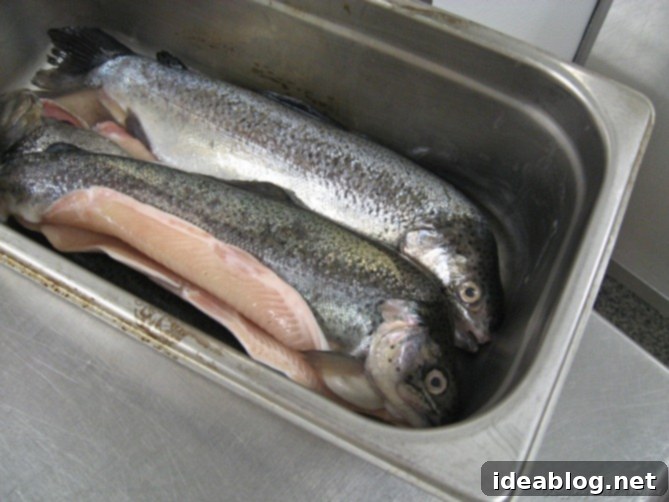
The preparation began with meticulous attention to detail, a hallmark of French cooking. We started by carefully trimming and removing the pesky pin bones from each rainbow trout fillet. This step is crucial not only for diner enjoyment but also for showcasing precision in our knife skills. Ensuring the skin remained perfectly intact was paramount for achieving that desirable crispy finish, which adds a wonderful textural contrast. Once the fillets were impeccably prepared, they received a light, even dusting of flour – a crucial step for achieving a golden-brown, flavorful crust. Each fillet was then seared to perfection over medium-high heat in clarified butter, a fat renowned for its high smoke point and pure flavor, which prevents burning and imparts a delightful nutty aroma to the fish.
Crafting the Grenobloise Sauce A La Minute
The true beauty of Grenobloise sauce lies in its swift and fresh preparation. Once our fish was perfectly seared and delicately set aside to rest, we swiftly assembled the sauce À LA MINUTE, meaning “at the last minute,” to ensure maximum freshness and vibrancy. The fundamental components were similar to our previous Meuniere sauce – rich brown butter, bright lemon juice, and finely chopped fresh parsley – but the distinctive character of Grenobloise emerged with the thoughtful integration of tangy capers and delicate, crunchy baby croutons. As a dedicated fan of capers, I was thrilled with this addition; their briny burst perfectly complemented the richness of the trout and the nutty butter.
The baby croutons, lightly toasted to a golden crisp, were not merely a garnish but an integral textural element, sprinkled generously over the finished fish. They provided a fantastic crunch that beautifully contrasted with the tender trout and the silky, emulsified sauce. To further enhance the dish’s bright, fresh profile, we expertly performed a peler à vif on a fresh lemon, a precise technique for segmenting the juicy flesh without any bitter pith or membrane. These vibrant lemon segments were then carefully placed on top, adding both visual appeal and an intense, concentrated burst of citrus. This simple yet sophisticated dish proved once again that often, the most satisfying culinary experiences come from mastering classic, straightforward preparations with high-quality ingredients.
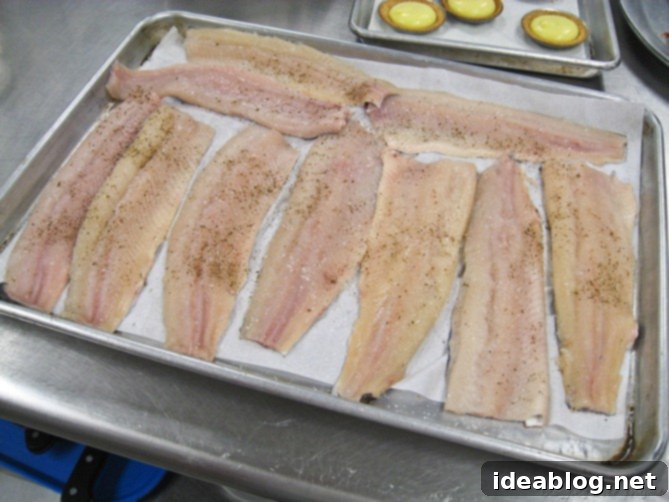
Exploring Braised Endive: A French Culinary Tradition
Accompanying our exquisite trout was a side of braised endive. While perhaps not as universally beloved as some other vegetables in global cuisine, endive is a respected staple in French culinary tradition, often appreciated for its distinctive bitter notes and elegant presentation. For this specific preparation, we started by carefully cutting the endives lengthwise, a simple yet effective way to ensure even cooking and a visually appealing final product. These halved endives were then meticulously arranged in a lightly greased sautoir pan, a shallow, straight-sided pan perfect for sautéing and braising, ensuring optimal contact with the heat.
A small but significant amount of chicken stock was added to the pan, providing essential moisture and a subtle savory depth to the endives during the braising process. The pan was then topped with a cartouche lid – a parchment paper circle precisely cut to fit just inside the pan, resting directly on the food. This clever technique helps to prevent excessive evaporation, creating a moist, steamy cooking environment that gently tenderizes the endives without allowing them to brown excessively. The pan was then placed in a preheated oven, where the endives slowly braised until they reached an incredibly tender, almost meltingly soft consistency, strikingly reminiscent of very soft leeks in texture.
This method of preparing endives is indeed very popular in France, often served as an elegant and traditional side dish in various settings. However, for many palates, especially those unaccustomed to strong bitter flavors, the braising process can actually intensify the inherent bitterness of the endive leaves, rather than mellowing it. I found the dish deeply interesting from a culinary perspective, appreciating the technique and diligently eating my portion. Yet, I must admit, it wasn’t my personal favorite component of the meal, and I suspect it rarely earns top marks among culinary students. Nevertheless, it served as a valuable lesson in understanding the nuances of vegetable preparation, balancing flavors, and appreciating diverse regional culinary preferences.
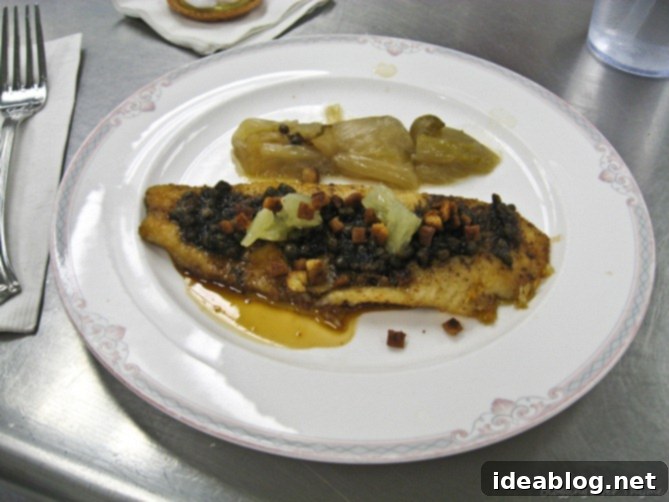
Gnocchis à la Romaine: A Semolina Surprise from Italy
Serving as a substantial and equally filling appetizer alongside the trout, we prepared GNOCCHIS À LA ROMAINE. These are distinctly different from the potato or ricotta gnocchi varieties that most people are familiar with; they represent a unique and flavorful Roman-style gnocchi made primarily with semolina flour. This gives them a unique, almost polenta-like texture that is both comforting and satisfying. This particular dish holds a special place for me, as my Italian mother has made it many times at home throughout my childhood, making it a comforting and familiar taste.
The process of making these gnocchi is quite fascinating and involves a stovetop-based method. It begins with bringing milk to a gentle simmer, into which semolina flour is gradually whisked. This creates a thick, savory porridge-like base, which requires constant stirring to prevent lumps and ensure a smooth consistency. To this rich base, generous amounts of butter, grated Parmesan cheese, and beaten eggs are incorporated, creating a smooth, thick dough that is surprisingly pliable. For our version in class, we seasoned it generously with freshly grated nutmeg, along with salt and pepper, enhancing its savory depth and aromatic profile. The warm mixture is then carefully spread onto a baking sheet, typically to about half an inch thick, and allowed to cool completely and set firm. Once chilled, it’s precisely cut into elegant large rounds, which are then ready for their final delicious transformation.
While these semolina gnocchi can certainly be served soft and warm straight from the pan, the classic Roman method involves a further crucial step to develop their flavor and achieve a delightful textural contrast. We meticulously arranged our chilled semolina rounds in an oven-safe dish, ready for their delicious topping. For the accompanying sauce, we crafted a vibrant fennel and tomato sauce, drawing thoughtful inspiration from the method used for the tomato and pesto sauce that accompanied our homemade pasta earlier in the course. To elevate the inherent anise flavor profile, we incorporated crushed fennel seeds and a subtle touch of Pernod, a classic French anise-flavored spirit that imparts an incredibly aromatic and distinctive scent. Topped with a generous sprinkle of freshly grated Parmesan cheese, the gnocchi were then heated in the oven until bubbling, golden, and slightly crisp around the edges, achieving a beautifully crisp exterior and tender interior. Delicious, surprisingly hearty, and incredibly versatile, these gnocchi are a true testament to the diverse and inventive nature of Italian cuisine.
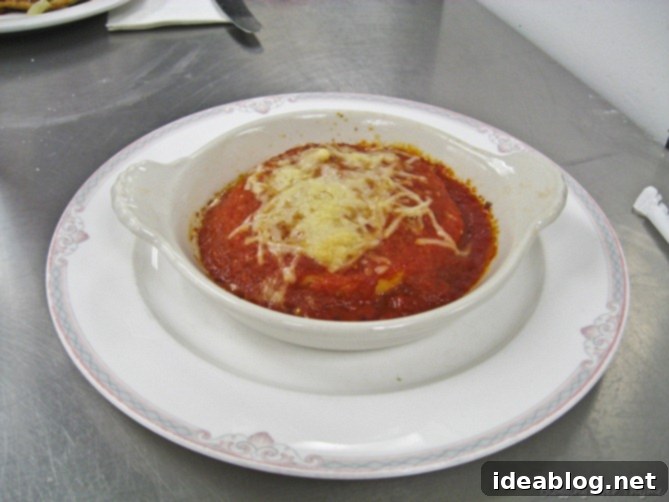
Key Lime Meringue Tartlettes: A Zesty Finale
The absolute highlight of the day for many, including myself, was undoubtedly the dessert: exquisite KEY LIME MERINGUE TARTLETTES. I had spotted them on the morning menu and had been eagerly anticipating their creation all day. For the vibrant filling, we opted for a very high-quality bottled pure key lime juice, which ensures consistency and an intensely tart flavor, though fresh lemon or Meyer lemon juice would also work beautifully, offering slightly different but equally delightful nuances. The key lime’s distinct tartness and aromatic zest make it a perfect choice for a refreshing and memorable dessert.
For the delicate tart shells, we had a practical choice to make: prepare a basic pie dough crust from scratch or utilize leftover PÂTE SUCRÉE from a previous week’s lesson. My team, ever strategic, opted for the latter. This decision was key to saving precious prep time, especially given the day’s ambitious and extensive menu. While the results are similar, Pâte Sucrée, a sweet shortcrust pastry, is known for offering a slightly richer and sweeter base, which wonderfully complements the intense tartness of the key lime curd. We meticulously shaped these tiny tartlets, each a delicate inch and a half in diameter, blind baking them to achieve a perfectly crisp and golden shell before adding our classic, tangy key lime curd filling. As someone utterly obsessed with anything tart and lemony, these tartlets were absolutely “right up my alley” – a perfect balance of sweet, tangy, and rich, promising a delightful sensory experience.
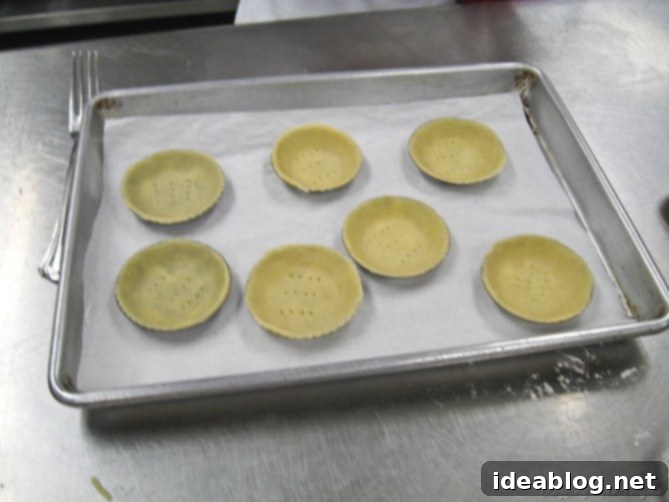
Mastering Swiss Meringue for the Topping
Once our delicate tart shells were filled with the luscious key lime curd, our focus shifted to creating the perfect meringue topping. We specifically prepared a Swiss hard meringue, a sophisticated technique prized in patisserie for its exceptional stability, silky texture, and brilliant sheen. The intricate process began with gently whisking together fresh egg whites (approximately 3 ounces) and granulated sugar (6 ounces) over a bain-marie, or double boiler. This slow, controlled heating is crucial; it ensures that the sugar dissolves completely into the egg whites, creating a smooth and incredibly stable base without prematurely cooking the eggs. Achieving the correct temperature is vital for the meringue’s ultimate structure.
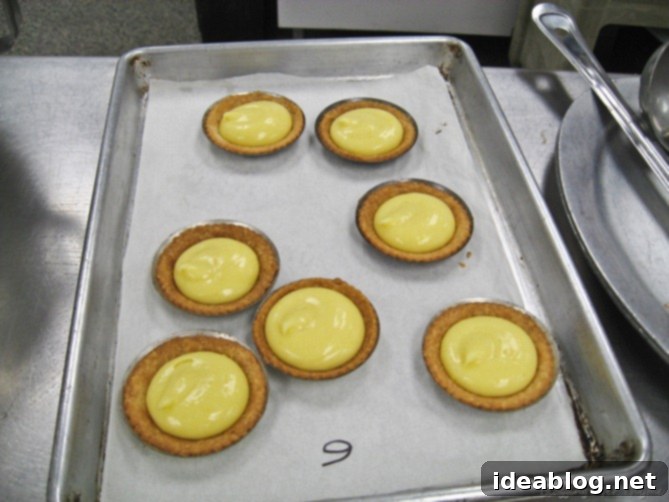
After the sugar was fully dissolved and the mixture was warm to the touch, we carefully transferred it to a stand mixer. Here, we beat the mixture vigorously at high speed until the meringue transformed into stiff, glossy peaks – a clear tell-tale sign of a perfectly stable and airy meringue, ready for piping. With the meringue at its peak, we meticulously piped a delicate swirl onto each tart, aiming for both beauty and consistency. For the final, aesthetically pleasing touch of browning the meringue, we had two distinct options: a culinary blowtorch for quick caramelization or the more controlled environment of the oven. Our chef demonstrated using the blowtorch, which, while visually impressive and swift, unfortunately resulted in a few slightly scorched tips on our tartlets. We quickly learned from this experience that the oven often provides a much more even and controlled browning, offering a gentler, all-over golden hue that is often preferred for larger batches. Despite the minor torching mishap, these tartlets were utterly delicious, with a wonderfully marshmallow-y texture that perfectly complemented the intense, zesty filling. Their perfectly portioned 2-3 bite size made them the ideal sweet treat – a truly delightful and memorable end to our extensive culinary day.
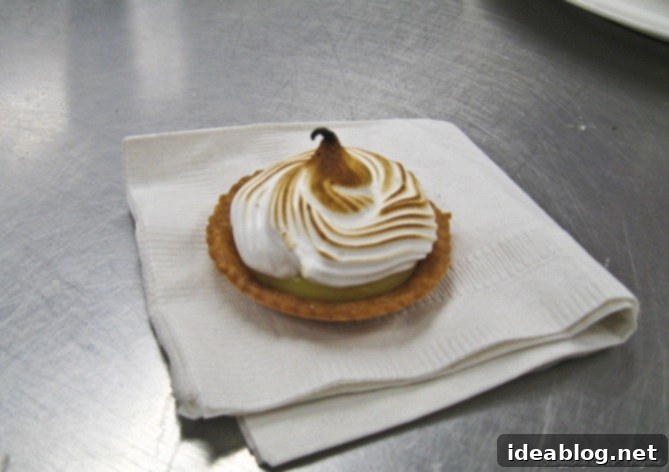
Evening Tutorials: Crème Anglaise & Homemade Brioche
After enjoying our hard-earned lunch, we briefly delayed the inevitable and extensive kitchen clean-up for two exciting and incredibly essential tutorials that promised to expand our foundational knowledge. First, we delved into the creation of CRÈME ANGLAISE, a classic cold sauce or pouring custard that serves as a fundamental building block in French patisserie. This versatile sauce, typically delicately flavored with vanilla, is often elegantly served alongside fruit tarts, rich chocolate cakes, or simply as a light, sophisticated dessert on its own. Understanding its precise emulsion, delicate tempering process, and achieving the perfect nappe consistency (the ability to coat the back of a spoon) is key to mastering many advanced dessert preparations.
Next, we enthusiastically embarked on the journey of making homemade BRIOCHE bread. This was a particularly anticipated session for me; despite my deep love for working with yeast and enriched doughs, I had never before tackled the intricate process of brioche. This rich, tender, and slightly sweet bread, distinguished by its exceptionally high butter and egg content, is a cornerstone of French baking and a true test of a baker’s skill. Our class, working diligently in teams, prepared the brioche dough, which is now undergoing its initial crucial resting phase in the kitchen. It will undergo two more vital rises and rests, often including an overnight cold proof, before finally being baked to golden perfection tomorrow morning. The anticipation of seeing and tasting our homemade brioche, knowing the effort and precision involved, is almost palpable and promises a rewarding experience.
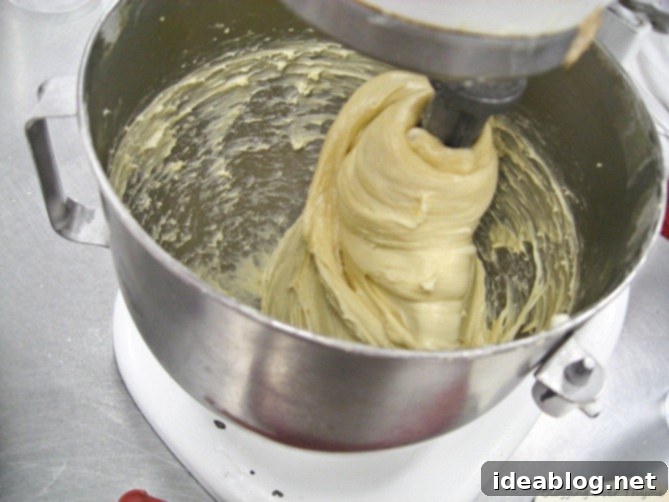
The Unsung Hero: Kitchen Cleanup and the Culinary Journey’s Demands
Following a day filled with intense cooking, intricate preparations, and continuous learning, the reality of culinary school often culminates in a lengthy and demanding clean-up session. This particular day included not only the usual meticulous scrub-down of every surface and utensil but also an extensive chicken bone trimming task, preparing essential stock ingredients for future lessons. As my feet ached and my back protested from hours of standing and bending, it was abundantly clear that this was the most physically challenging and least glamorous, yet utterly essential, part of the day. Unfortunately, our class is quite small; we’ve actually had two students drop out since the beginning of the program, meaning the remaining members have to put in double the effort and maintain exceptional teamwork to ensure everything is meticulously cleaned, organized, and prepared for the next day, all while staying perfectly on our demanding schedule.
Despite the physical toll, the long hours, and the relentless demands of a professional kitchen environment, every moment in culinary school feels immensely worthwhile. The profound knowledge gained, the invaluable skills honed, and the immense satisfaction of creating truly exceptional and beautiful dishes far outweigh the arduous tasks. It’s a journey fueled by passion, demanding perseverance, and characterized by continuous learning, ultimately transforming raw ingredients into edible art and aspiring cooks into confident chefs.
I’ll be back tomorrow with another insightful daily recap, sharing more delicious insights into our exciting culinary adventures! Thank you for your continued positive feedback and keen interest in these posts. Your support truly means the world and motivates me to share every detail of this incredible journey!
